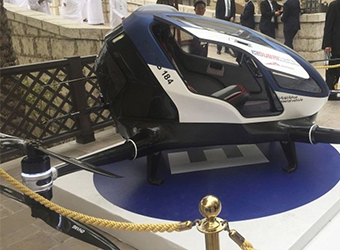A drone that can carry people will begin regular operations in Dubai from July, the head of the city’s Roads and Transportation Agency has announced at the World Government Summit.
The Chinese model eHang 184 has already had test flights, said Matt al-Tayer.
The drone can carry one passenger weighing up to 100 kg (220 pounds) and has a 30 minutes-flight time.
The passenger uses a touch screen to select a destination. There are no other controls inside the craft.
It is auto-piloted by a command centre, according to a video released by the government agency.
It has reported speeds of up to 100 miles per hour (160 kilometres per hour) and can fly 31 miles (50km) on a single battery charge.
“This is not only a model,” Mr al-Tayer, according to a report by the Associated Press.
“We have actually experimented with this vehicle flying in Dubai’s skies.”
The device was also approved for testing in Nevada in June 2016.
Dr Steve Wright, senior lecturer in avionics and aircraft systems at the University of the West of England, told the BBC that safety would have to be paramount.
“The way these systems work, making them work normally is easy. The tricky bit is making systems that are resilient to failure,” he said.
“I would like to see the drone flying for at least 1000 hours before I saw a human in it.”
Wright added that he would not be volunteering for an early flight.
“I’d have to be taken on board kicking and screaming.”
Last month Israeli firm Urban Aeronautics announced that its Cormorant passenger drone – designed for military use – could be in use by 2020.
The $14m (£11m) drone can carry 500kg (1,100lb) at 185km/h (115mph).
Source: BBC A drone that can carry people will begin “regular operations” in Dubai from July, the head of the city’s Roads and Transportation Agency has announced at the World Government Summit.
The Chinese model eHang 184 has already had test flights, said Matt al-Tayer.
The drone can carry one passenger weighing up to 100 kg (220 pounds) and has a 30 minute flight time.
The passenger uses a touch screen to select a destination. There are no other controls inside the craft.
It is auto-piloted by a command centre, according to a video released by the government agency.
It has reported speeds of up to 100 miles per hour (160 kilometres per hour) and can fly 31 miles (50km) on a single battery charge.
“This is not only a model,” al-Tayer, according to a report by the Associated Press.
“We have actually experimented with this vehicle flying in Dubai’s skies.”
The device was also approved for testing in Nevada in June 2016.
Steve Wright, senior lecturer in avionics and aircraft systems at the University of the West of England, told the BBC that safety would have to be paramount.
“The way these systems work, making them work normally is easy. The tricky bit is making systems that are resilient to failure,” he said.
“I would like to see the drone flying for at least 1000 hours before I saw a human in it,” he stated.
Wright added that he would not be volunteering for an early flight.
“I’d have to be taken on board kicking and screaming,” he said.
Last month Israeli firm Urban Aeronautics announced that its Cormorant passenger drone – designed for military use – could be in use by 2020.
The $14m (£11m) drone can carry 500kg (1,100lb) at 185km/h (115mph).
Source: BBC


